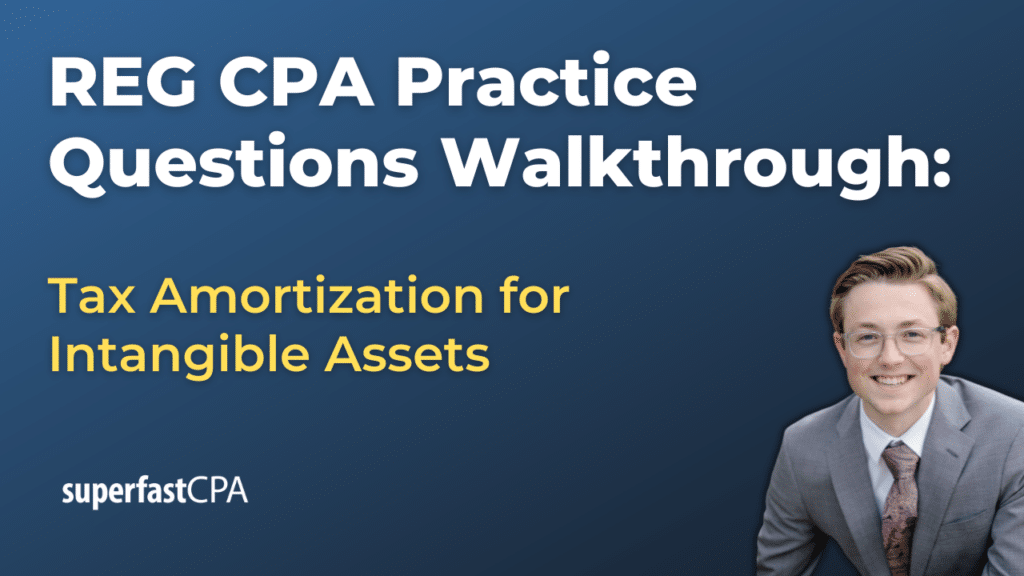In this video, we walk through 5 REG practice questions demonstrating how to calculate tax amortization for intangible assets. These questions are from REG content area 3 on the AICPA CPA exam blueprints: Taxation of Property Transactions.
The best way to use this video is to pause each time we get to a new question in the video, and then make your own attempt at the question before watching us go through it.
Also be sure to watch one of our free webinars on the 6 “key ingredients” to an extremely effective & efficient CPA study process here…
How to Calculate Tax Amortization for Intangible Assets
Calculating tax amortization for intangible assets involves a systematic process defined under the U.S. tax code, particularly under Section 197. This process allows businesses to deduct the cost of certain intangible assets over a specified time period, which is generally 15 years for the assets covered under Section 197. Let’s gain an understanding of what makes an asset qualify under this section, how the amortization works, and other tax considerations for businesses to accurately account for their intangible assets and optimize their tax positions.
Qualifying Assets Under Section 197
Intangible assets must meet specific criteria to be eligible for amortization under Section 197. These criteria mainly include, but are not limited to:
- Acquisition through Purchase: The intangible asset must be acquired through purchase or a transaction that involves the acquisition of assets constituting a business or a substantial part of a business.
- Use in Business: The asset must be held for use in a trade or business or for the production of income.
- Have a Determinable Useful Life: The asset must have a useful life that extends beyond the tax year but does not necessarily need to have a precisely determinable useful life.
- Exclusions: Certain assets are explicitly excluded from Section 197 amortization, despite meeting the other criteria. These include:
- Interest in businesses, such as stock or partnership interests.
- Certain created intangibles (unless they are created in connection with the acquisition of a business).
- Assets not acquired in connection with the acquisition of a business or a substantial part of a business.
- Real property, tangible personal property, and certain other tangible assets.
- Certain software not acquired in connection with the acquisition of a business.
Eligible intangible assets under Section 197 include goodwill, going-concern value, business books and records, operating systems, patents, trademarks, and customer-based intangibles, among others.
How Amortization Works for Intangible Assets Under Section 197
Once it’s determined that an intangible asset qualifies under Section 197, the process for amortization involves the following steps:
- Determine the Amortizable Basis: This is generally the amount you paid for the asset, adjusted for certain items such as gifts or inheritances.
- Straight-Line Amortization: The cost of the asset is amortized over a 15-year period, starting with the month the intangible asset was acquired or the month of starting business, whichever comes latest. This means the annual amortization expense is the amortizable basis of the asset divided by 15.
- Report on Tax Returns: Taxpayers must file Form 4562 to report depreciation and amortization and attach a statement to their tax return detailing the name and type of each Section 197 intangible for which amortization is being claimed.
Other Tax Considerations
- Anti-Churning Rules: Section 197 includes anti-churning rules to prevent taxpayers from acquiring assets from related parties to claim amortization deductions.
- Dispositions: If a Section 197 intangible is disposed of before the end of the 15-year amortization period, the unamortized basis can’t be immediately deducted. Instead, it is generally taken into account over the remainder of the 15-year period.
- Impact on Earnings: While tax amortization can reduce taxable income, it doesn’t impact the book value of intangibles on financial statements prepared according to GAAP (Generally Accepted Accounting Principles).
Example:
Imagine that Company A acquires Company B for $1,000,000. As part of the acquisition, an appraisal is conducted, and it is determined that $300,000 of the purchase price is attributable to goodwill, an intangible asset eligible for amortization under Section 197.
Step-by-Step Calculation
1. Determine the Amortizable Basis of the Asset
The amortizable basis is the amount paid for the asset. In this case, Company A’s amortizable basis in the goodwill is $300,000.
2. Calculate the Annual Amortization Expense
Under Section 197, the goodwill must be amortized on a straight-line basis over 15 years (180 months), starting with the month of acquisition.
- Annual Amortization Expense: $300,000 / 15 years = $20,000 per year
3. Monthly Amortization Calculation
If the asset was acquired partway through the year, you would also calculate the monthly amortization for the partial year. Assuming the acquisition occurred in July, the amortization for the year of acquisition would be calculated from July to December (6 months).
- Monthly Amortization Expense: $20,000 / 12 months = $1,666.67 per month
- Amortization Expense for Partial Year: $1,666.67 * 6 months = $10,000
Therefore, for the year of acquisition, Company A can deduct $10,000 as an amortization expense for the goodwill. For each of the next 14 years, Company A will deduct $20,000, and for the final (15th) year, the deduction will be adjusted to account for the partial year of amortization if necessary, ensuring the total amortization does not exceed the amortizable basis of $300,000.
Reporting the Amortization Deduction
Company A would report this amortization deduction on its tax return, using Form 4562 to provide the IRS with information on the depreciation and amortization. The form would include the name of the asset (goodwill), the date acquired, and the amount of amortization deduction claimed for the year.













